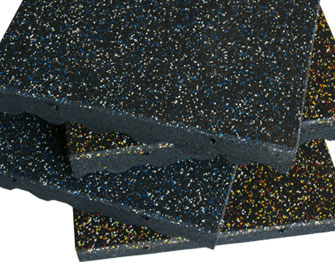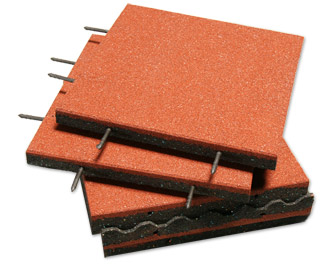|
|
Rubber playground tiles are made of durable and weather resistant recycled rubber crumb and can provide a non-slip and cushioned playground surface. Creating a soft playground surface is important in creating a safe environment for children to play on without worry of possible life-threatening injuries. A recycled rubber playground surface made from outdoor play tiles retains outstanding environmental resistance properties and can create safe and soft playground flooring. In addition, because most playground injuries occur because of falls off playground equipment and onto a hard surface, playground equipment flooring should have shock absorption properties to ensure safety. Furthermore, rubber playground tiles are ideal playground surfacing options due to their natural non-slip properties that are not affected by wet weather conditions.
What are Rubber Playground Tiles Made of?
Rubber playground tiles are made of recycled rubber crumb due to their excellent environmental resistance and cushioning properties. Rubber is the ideal material for creating playground equipment flooring because it can offer a level of safety by providing a safe and soft playground surface. A recycled rubber playground surface, in particular, is the ideal playground flooring option due to its excellent environmental resistance properties that allows it to remain outdoors indefinitely without worry of damage. Recycled rubber is considered a tire derived product, or TDP, meaning it is made of post-consumer vehicle tire rubber that has been ground up and re-adhered. It retains excellent environmental resistance properties as vehicle tires experience rough terrain and weather daily; therefore, products made from recycled rubber will retain the same durable properties, making it the ideal material for creating outdoor play tiles. More material attributes that make recycled rubber the ideal material for playground equipment flooring include high surface friction, softness, water impermeability, high density, and low UV degradation rate. These beneficial attributes of recycled rubber translate into safety and performance enhancements when used as playground surfacing. Case in point, tire rubber attributes, such as high surface friction, softness, water impermeability, and low UV degradation rate, allow recycled rubber to offer performance enhancements, including slip resistance, fall height safety, and excellent outdoor life (green-technology.org). In other words, a recycled rubber playground surface is a resilient and long-lasting surfacing option that makes for excellent outdoor play tiles. Unlike other surfacing options, such as concrete and asphalt, which are hard, susceptible to cracking, and corrosive, recycled tire rubber surface is “lightweight, crack resistant, flexible, shock absorbing, and waterproof” (green-technology.org). Rubber playground tiles made of recycled rubber crumb are the ideal playground surfacing products due to their long-lasting outdoor properties as well as their excellent safety features.

|

|
-
(a) What is the Purpose of a Rubberized Surface?
The purpose of a rubberized surface is to provide a softer and safer surface to land on in case of a tumble and to create a non-slip surface. Rubber playground tiles are made of shock absorbing recycled rubber materials that offer a softer surface to land on rather than other playground surfacing options, such as sand or woodchips. For instance, “Rubber or elastomeric materials are widely used for shock absorbers having elastic and viscous properties such as high inherent damping, deflection capacity, and energy storage” (jounals.sagepub.com). These properties allow rubber playground tiles to efficiently absorb the force of impact to create a safe and soft playground surface. Using rubber playground tiles is very important for maintaining safety as most playground injuries are the result of falls off playground equipment rather than being hurt from the equipment themselves. In fact, about 60% of all playground injuries are the result of falls off playground equipment and onto the ground (cpsc.gov). Additionally, another purpose of a rubberized surface is to offer non-slip safety. This is made possible thanks to rubber’s high coefficient of friction which gives it a naturally grippy surface that is not affected by moisture on its surface.
What is Protective Fall Surfacing?
Protective fall surfacing is a soft surfacing option that can absorb the force of impact to create a safe landing surface. Rubber playground tiles are the ideal products for creating impact surfacing due to their excellent shock absorption properties. Most playground related injuries are direct results of children falling onto hard and unsafe surfaces. It is important to install playground equipment flooring with good shock absorption capabilities as a fall onto a shock absorbent surface is less likely to cause a life-threatening injury. Case in point, according to the Handbook for Playground Safety by the U.S. Consumer Product Safety Commission, “The surface under and around playground equipment can be a major factor in determining the injury-causing potential of all…the more shock absorbing a surface can be made, the greater is the likelihood of reducing severe injuries” (cpsc.gov). For a playground surface to meet safety requirements, it must meet all the requirements found in ASTM F1292, Fall Height Standards and ASTM F1951, Accessibility Standard of Surface Systems (calrecycle.ca.gov). Because playground equipment can all be different heights, it is important to understand critical height. Critical height refers to “the shock absorbing performance of a surfacing material and is used in this part as an approximation of the maximum fall height from which a life-threatening head injury would not be expected to occur” (ilga.gov). Protective fall surfacing should take into consideration the type of equipment used in the playground and how high they rise above the playground’s surface. This will ensure that the surface around the playground equipment can offer sufficient shock absorption to prevent life-threatening injuries.

|

|
Is Rubber Flooring Good for Kids?
Rubber flooring is good for kids due to its shock absorbing and traction-enhancing properties. Rubber playground tiles offer a softer surface than other playground surfacing options, including woodchips, sand, or turf, thanks to their superior shock absorption properties. Harder surfaces can cause more serious injuries, especially when they involve any sort of head injury. Contrastingly, rubber playground tiles, although strong and durable, are soft and can absorb the force of impact. Outdoor play tiles also offer a naturally grippy surface that helps further prevent slip and fall accidents by enhancing traction. This is due to rubber’s natural high coefficient of friction that allows it to retain its grippy surface regardless of whether moisture is present on its surface. Rubber’s moisture resistance does not allow for the permeation of moisture; instead, moisture stays on its surface, allowing rubber to keep its grippy surface. Rubber playground tiles are made of recycled rubber which offers a textured surface, adding to rubber’s already grippy surface for enhanced traction.
A recycled rubber playground surface is the ideal playground surfacing option due to all the safety benefits recycled rubber can offer. Rubber playground tiles made of recycled rubber crumb can offer excellent shock absorption and non-slip properties that ensure a safe surface for children. As outdoor play tiles, recycled rubber playground tiles are highly resistant to the damaging effects of environmental factors, such as UV rays, ozone, oxygen, and moisture, allowing them to remain durable safety tiles for years in the outdoors. Using a soft playground flooring option, such as recycled rubber playground tiles, can significantly reduce chances of a life-threatening injury. Overall, rubber playground tiles not only offer a safe and non-slip playground surface, but they also offer long-lasting durability in the face of harsh environmental conditions.
What are Rubber Playground Tiles Made of?
|
|
|